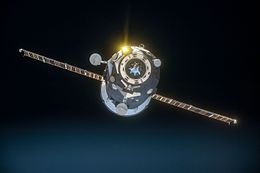Progress MS-01
 | |
| Mission type | ISS resupply |
|---|---|
| Operator | Roscosmos |
| COSPAR ID | 2015-080A |
| SATCAT no. | 41177 |
| Spacecraft properties | |
| Spacecraft type | Progress-MS No.431[1] |
| Manufacturer | RKK Energia |
| Start of mission | |
| Launch date | 21 December 2015, 08:44:39 UTC[2][3] |
| Rocket | Soyuz 2.1a [4] |
| Launch site | Baikonur 31/6 |
| End of mission | |
| Disposal | Deorbited |
| Decay date | July 3, 2016 at 7:03 UTC |
| Docking with ISS | |
| Docking port | Pirs nadir |
| Docking date | 23 December 2015, 10:27 UTC[5] |
| Undocking date | 2 July 2016, 23:48 UTC[6] |
| Time docked | 192 days |
Progress ISS Resupply | |
Progress MS-01 (Template:Lang-ru), identified by NASA as Progress 62 or 62P is a Progress spacecraft used by Roskosmos to resupply the International Space Station (ISS) during 2015. It was launched on December 21, 2015, to deliver cargo to the ISS. Progress MS-1 is the first vehicle in the Progress-MS series.[7]
Launch
The launch was initially scheduled for 21 November 2015.[8] Progress MS-1 was launched on 21 December 2015 at 08:44:39 UTC[3] from the Baikonur Cosmodrome in Kazakhstan.
Docking
Progress MS-1 docked with the Pirs docking compartment on 23 December 2015 at 10:27 UTC.[5]
Technology
The Progress MS spacecraft has upgraded communications and electronics from previous Progress vehicles. After launch, ground controllers were able to communicate the Progress MS via a Russian Luch data relay satellite in geosynchronous orbit. This was described as the first time a Progress or Soyuz spacecraft had such capability.[9]
Other upgrades include:
- Upgraded Kurs-A rendezvous system designated Kurs-NA, including new antennas
- Upgraded flight control system that can take advantage of the GLONASS navigation satellites for the first time, for autonomous trajectory measurements
- New digital television system, which replaced an older analog TV, allowing transmission between the transport ship and the space station via onboard radio channels.
- New digital backup control unit
- Enhanced meteoroid shielding
- New LED-based lighting system
- Upgraded angular velocity sensors
- Docking port equipped with a backup electric driving mechanism
Progress MS-1 was launched on a Soyuz-2, the first launch of the rocket since the failed launch of Progress M-27M. The Soyuz-U rocket was used for subsequent Progress flights until this flight.[10]
Reentry
The upper stage reentry was visible over Arizona and Nevada on December 22 at 5:30 UTC.
The spacecraft initiated the de-orbit maneuver on July 3, 2016 at 7:03 UTC, with an expected landing of any possible debris on the Pacific Ocean by 7:50. UTC
References
- ^ "Progress-MS 1 - 8". Gunter's Space Page. Retrieved 23 December 2015.
- ^ "International Space Station Calendar". spaceflight101.com. 2015-10-04. Retrieved 4 October 2015.
- ^ a b "Launches and Orbital Operations". Zarya. Retrieved 16 December 2015.
- ^ "Progress-MS 1 - 8". space.skyrocket.de. 2015-10-04. Retrieved 4 October 2015.
- ^ a b Rincon, Paul (23 December 2015). "ISS crew receives Christmas delivery". BBC News. Retrieved 23 December 2015.
- ^ Zak, Anatoly (July 3, 2016). "First Progress-MS ends its mission". www.russianspaceweb.com. Retrieved 18 July 2016.
- ^ "Progress-MS to be Launched on December 21". russianspacenews.com. 2015-10-04. Retrieved 4 October 2015.
- ^ Nowakowski, Tomasz (29 October 2015). "Russia postpones maiden flight of its Progress-MS spacecraft". Spaceflight Insider. Retrieved 17 December 2015.
- ^ Zak, Anatoly (23 December 2015). "Soyuz rocket flies critical test mission with Progress-MS". russianspaceweb.com. Retrieved 23 December 2015.
- ^ Zak, Anatoly (23 December 2015). "Soyuz rocket flies critical test mission with Progress-MS". russianspaceweb.com. Retrieved 23 December 2015.

